The Samsung Galaxy Note5 and Galaxy S6 edge+ Review
by Joshua Ho on October 2, 2015 8:00 AM ESTDisplay
With the rise of smartphones and tablets, the display has become one of the most important aspects of a mobile device as it’s the primary mode of interaction. However, throughout computing the display has generally had relatively little attention. People might have talked about resolution, size, and latency, but the discourse was vague at best. In order to really understand displays, it’s important to discuss a number of factors that affect display quality and the underlying design of the display. These factors range from subpixel arrangement to TFT structure and various emitter materials. With traditional reviewing methods, it’s often difficult to say one way or another whether one display is “better” than another. While simple metrics like maximum brightness can be compared in a relative manner, it’s hard to say whether one has better colors or higher static contrast. In order to test these metrics, we turn to objective measurements from devices like X-Rite’s i1Pro2 spectrophotometer and i1Display Pro colorimeter. In order to acquire the data from these devices and present it in a usable manner, we use SpectraCal’s CalMAN 5 with a custom workflow.
Under the microscope and based upon some quick viewing angle tests, subjectively the Galaxy Note5 display looks and feels like a bigger version of the Galaxy S6 display. Viewing angles for some angles feels like the display is almost painted on to the glass below, but some odd interference effects with viewing angle changes breaks the illusion to some extent. In the case of the S6 edge+, the curved edges of the display cause a noticeable shift in luminance when looking at the edge compared to the center of the display, which also causes an odd green shift which is probably due to the RGBG subpixel layout. I suspect the best LCDs will still be better at the “painted to the glass” illusion for the near future. This isn’t a huge deal, but it is a noticeable difference.
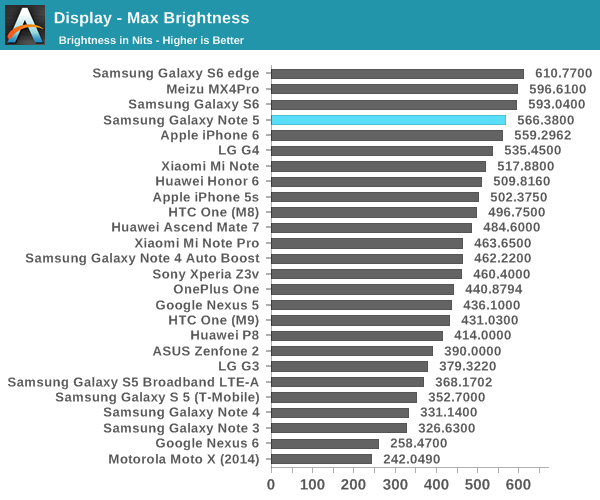
Moving on to our brightness testing, we can see that the Galaxy Note5 delivers a healthy improvement over the Galaxy Note 4 generation of AMOLED, but it isn’t quite at the same level as the Galaxy S6. It isn’t clear why this is the case, but I suspect this is related to longevity and other concerns outside of brightness. Meanwhile the use of OLED means that black levels are perfect and contrast remains solely determined by the lighting of the room and the reflectance of the display, which is similar to most other smartphones.
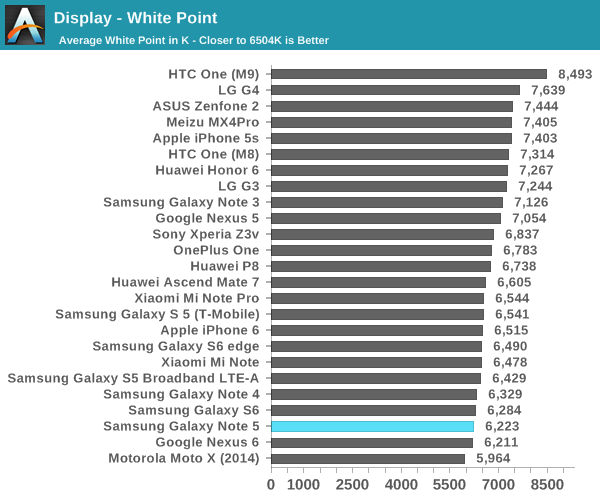
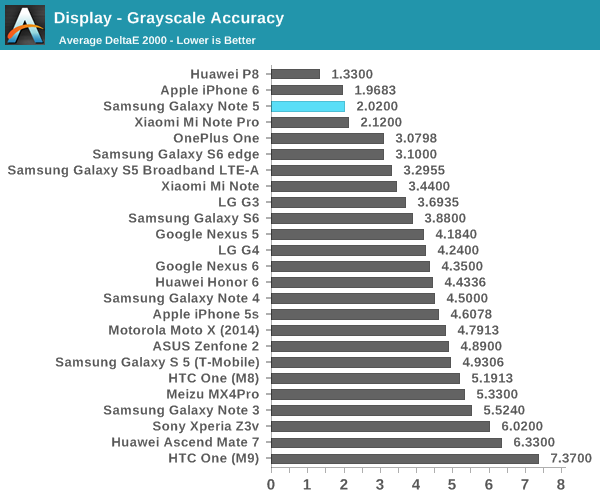
In our standard grayscale testing, the Note5 delivers acceptable color accuracy but it seems that the Basic screen mode tends towards a warm color balance. I suspect this helps with power efficiency, as blue in general requires more power to achieve the same level of luminance. Other than this slightly warm white balance, the grayscale accuracy doesn’t have any significant errors. This means accuracy ends up very good - certainly below our threshold for noticable errors - especially in comparison to the Galaxy Note 4 which had some noticeable problems with green tint on some units.
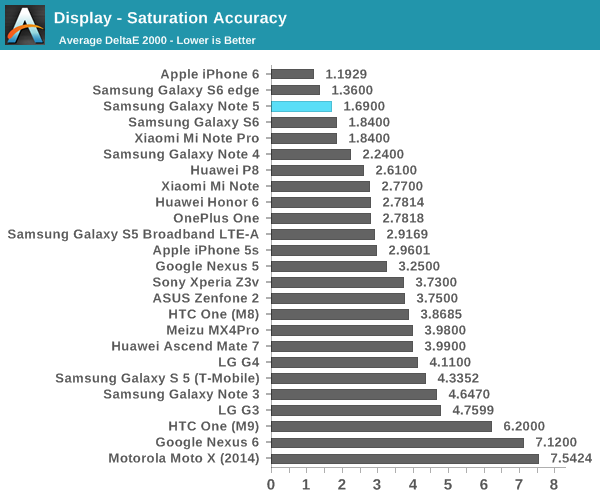
In our saturation test, Samsung does well enough that there’s really nothing to talk about because there's so little wrong here. You could argue that magenta is a bit warm on our review unit, but the difference is too small to be worth talking about. Error on average is going to be hard to spot unless you have a flawless reference monitor to compare against.
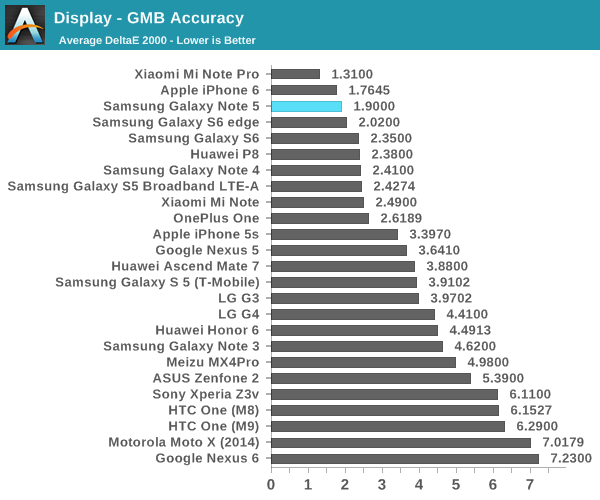
In the GMB ColorChecker test, Samsung continues to show a strong performance when looking at various hues that are commonly found in consumer content such as movies and camera photos. There’s a slight red shift on some of the tested hues, but the error is so minor I don’t notice that any problems here.
Overall, the Galaxy Note5 and Galaxy S6 edge+ both have an incredible display. The Galaxy S6 edge+ does have some problems with viewing angle shifts by virtue of the curved display, but this is effectively unavoidable given the subpixel layout and the radius of curvature. With this generation of AMOLED, Samsung has definitely equaled the best LCDs on the market. I suspect within the next year or two it will be inevitable that Samsung AMOLED will be clearly superior to even the best LCDs. However, without other OLED suppliers that can provide similar quality and cost I suspect OEM adoption will continue to be limited.



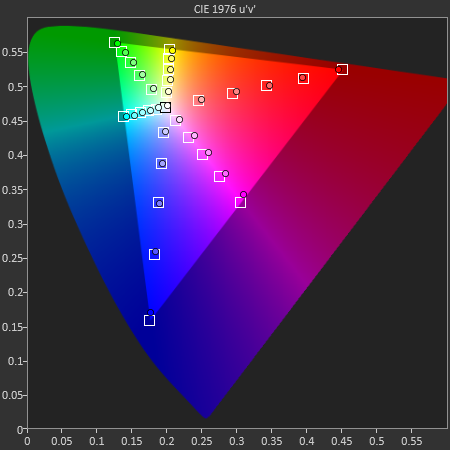
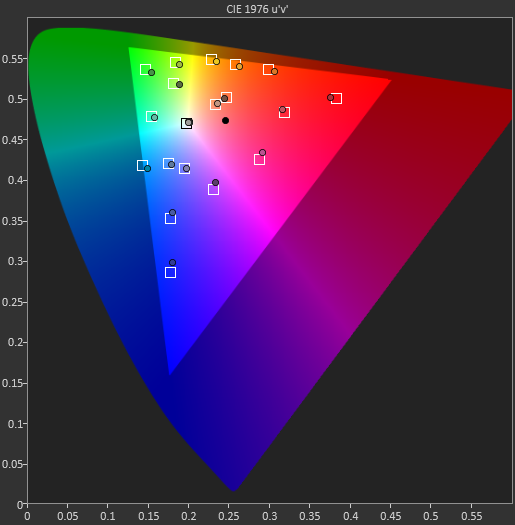








225 Comments
View All Comments
Le Geek - Friday, October 2, 2015 - link
I am curious as to why you referred to the new Note as the Note5 (without space) but the previous note was called Note 4.Ryan Smith - Friday, October 2, 2015 - link
That is the official name according to Samsung. It was the "Note 4" and for this iteration they've removed the space so that it's the "Note5".http://www.samsung.com/global/galaxy/galaxy-note5/
We typically follow the manufacturer's naming convention unless there's a problem in doing so.
danbob999 - Friday, October 2, 2015 - link
"With this generation of AMOLED, Samsung has definitely equaled the best LCDs on the market. I suspect within the next year or two it will be inevitable that Samsung AMOLED will be clearly superior to even the best LCDs"Anandtech has been saying this for years.
Kuzi - Saturday, October 3, 2015 - link
Except that in reality Amoled surpassed LCDs since 2014.Anandtech will not admit Amoled is great until Apple starts using it in their devices (my guess is next year). Of course Apple would bump up the resolution and give it a fancy name, and Anandtech will sing the praises of how amazing Apple's Amoled is. When in reality the screen panel will be made by Samsung or LG :p
PPI will become important and talked about by Anandtech again only when Apple bumps the resolution.
Peichen - Monday, October 5, 2015 - link
If AMOLED is anywhere close to IPS why aren't EIZO, NEC, Dell switch their professional lineup to AMOLED? Why are 31" calibrated IPS monitors going for $3000 while the same money can get you 55" 4K OLED TV?Just because your eyes cannot see the difference doesn't mean professionals cannot. That goes for your rant vis-a-vis iPhone.
Kuzi - Tuesday, October 6, 2015 - link
You can't compare Professional monitors with TVs. If these Dell. NEC monitors were using OLED technology then probably they would have cost double the amount.Also keep in mind that color accuracy of the Samsung OLED screens only became comparable to the best IPS LCDs since a year ago or so. So these manufacturers didn't get the chance yet to move to OLED. There are only cost and capacity considerations, it might be that Samsung is keeping all the capacity for themselves at this time.
Don't be surprised when in a year you see Apple move to OLED.
thedons1983 - Sunday, October 18, 2015 - link
LCD is crap compared to OLED, or AMOLED, there is no denying that, and those who don't buy into that fact, are utter morons. The reason they aren't yet ubiquitous, is cost. Every display will eventually replace LCD, with something superior, like OLED. Hence why top end Tvs are now transitioning to that tech, because it is simply much, much better technology. Apple just can't afford it, hence why they persist with inferior tech.Dobson123 - Friday, October 2, 2015 - link
Maybe it would be a good idea to address concerns regarding battery durability and quickcharge in the light of the non-removable battery. What should I do if my battery lost half it's capacity after 2 years? A normal user just can't buy a new on and change it himself.Peichen - Monday, October 5, 2015 - link
I'd like to know this as well. Maybe someone can go crazy and charge and discharge popular smartphones using its default charger for 100/200 cycles and run the same battery test to see if there are obvious signs of battery degradation.An iPhone 6s+, Z5, V10, Note 5, Moto X, Oppo something.
Infy2 - Friday, October 2, 2015 - link
Is the maximum display brightness reported here achievable simply with the brightness slider or just with the boost feature triggered by direct sunlight?